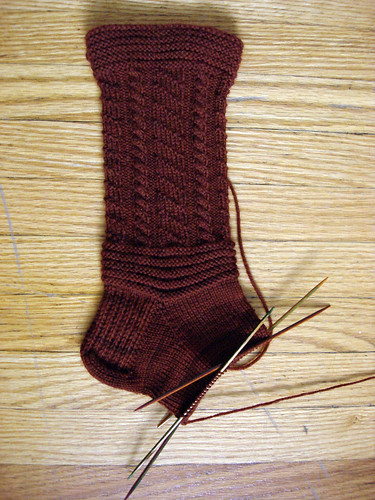Thanks to some lovely knitters who attended a conference held in Shetland recently, there are new and detailed pictures of old lace objects, and the group is currently working on this piece from the Shetland Museum. I might write some more later about why I am so moved by these projects—not just the finished knitted objects, but the reverse-engineering efforts—I suppose it drives home how enormously complicated the designing and knitting was, and what a brilliant mind you'd need to be able to knit these things without the benefit of charting software and a dozen other knitters double-checking your math.
Clearly this means that it's the right time for me to become fascinated by a completely different reverse-engineering project.
The Norfolk Museums & Archaeology Service has a website with dozens of pictures of ganseys on it. Some of the images are actual sweaters in the museum's collection, and others are scanned photographs and postcards. I think ganseys are great, as you know—I don't really care for all-over cabled designs but a little cable highlighting something else is fine, and brocade-like designs made of knits and purls knitted with sturdy yarn at a tight gauge? I love those. I think it's some desire to compensate for all the wispy impractical lace items I make.
The pictures of the fishermen are arresting.

(Black and white photographic postcard image printed in negative of Walter 'Primo' Allen at the wheel of the lifeboat.)
His sweater is just great—I love the horizontal ridges that set off the areas with different patterns, and I love the embossed look of those narrow zigzagging cables, and I love how it's plain past the elbows and at the bottom, where it would be prone to wearing out. Much easier to darn or reknit stockinette than a cable pattern. It's very handy that this practical feature also makes a handsome design element.
I'm playing with a sock pattern based on a different gansey from the collection, which belonged to a Henry Little.

(Henry Little's gansey; hand-knitted woollen blue pullover with typical Sheringham coil o' rope and bar pattern; worn very thin and repaired at the neck and cuff; probably knitted by Edie Middleton; two buttons at the collar.)
My modifications are to tighten up the cable a little by working fewer resting rows between patterned rows, and to add a couple extra purl stitches to the columns that separate the patterned sections. This is partly to add elasticity to the pattern and partly to facilitate hidden calf shaping (p2togs in that gutter are a very easy way to narrow the leg without interfering with the rest of the pattern at all). The foot will be plain, of course.

Here's my progress so far; it's most of one sock. I think gansey socks worked from old postcards and photographs would make a fun series of patterns or an interesting informal ebook project. I definitely need a new influx of wool socks, anyway.
4 comments:
Ooo, how cool! I really like the idea of gansey socks. They're charming!
I love Ganseys! I have one on the needles right now. In fact it's been on the needles for a few years. Regardless, ganseys and the history behind them are wonderful, as is Shetland knitting and patterns.
I'm planning to knit your mitten pattern soon. Love these socks too!
Thanks for keeping the traditions alive. Janet
What a fantastic idea! Love the idea of reclaiming a historical artifact and making it one's own. (Love how your sock is turning out thus far, too.) And a big WOW on the Queen Susan pattern - I had not seen that before, so thanks for pointing it out.
Thanks, guys!
Emily, the Queen Susan is just a staggering amount of work, isn't it? I think one person has finished knitting the entire thing so far.
Post a Comment